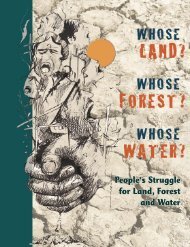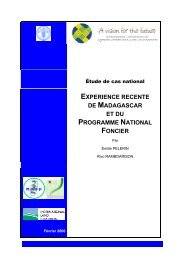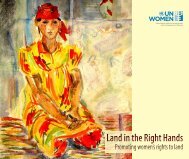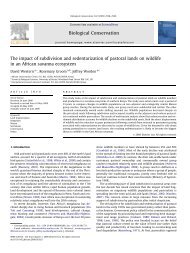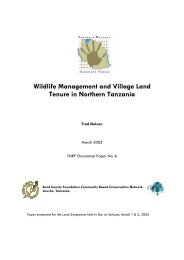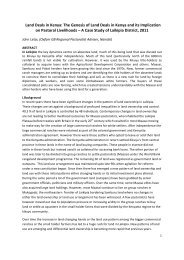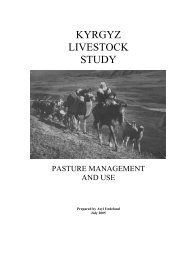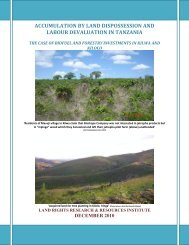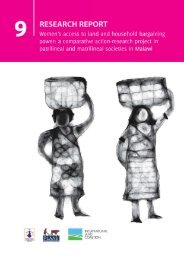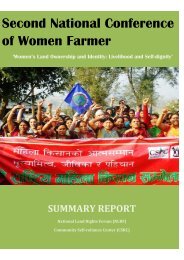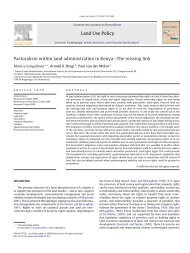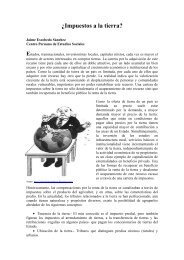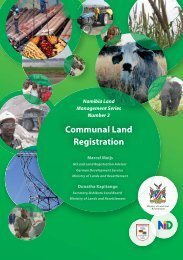Garba Tula Governance Assessment Final Report ... - Land Portal
Garba Tula Governance Assessment Final Report ... - Land Portal
Garba Tula Governance Assessment Final Report ... - Land Portal
Create successful ePaper yourself
Turn your PDF publications into a flip-book with our unique Google optimized e-Paper software.
<strong>Garba</strong> <strong>Tula</strong> <strong>Governance</strong> Baseline <strong>Assessment</strong>, April 2011<br />
Development of strategies and actions based on previous activities to help strengthen natural<br />
resource governance in the area, as well as the elaboration of indicators to measure this<br />
The results of these activities are set out in this report in the following six main sections:<br />
1. <strong>Governance</strong> <strong>Assessment</strong> Approach: Natural resource governance is highly complex and dynamic,<br />
involving multiple stakeholders and a variety of interconnecting institutions, laws, policies, and<br />
governance processes that impact on different aspects of natural resource use, management and<br />
human livelihoods. <strong>Garba</strong> <strong>Tula</strong> is no exception, and an important starting point for this study was to<br />
establish an assessment approach which enabled the identification of the key governance<br />
mechanisms that influence GT natural resource and livelihood values. This section sets out the<br />
rationale underlying the governance assessment approach adopted in this study, which also took<br />
account of IUCN’s broader Natural Resource <strong>Governance</strong> Principles.<br />
2. <strong>Garba</strong> <strong>Tula</strong> Natural Resource and Livelihoods Values and Challenges: An important preliminary step<br />
in assessing natural resource governance mechanisms is the identification of the most important<br />
natural resources in an area from conservation and livelihoods perspectives, the livelihoods that<br />
depend on these resources, and the major challenges and threats impacting on these values. This<br />
understanding is important from two perspectives: Firstly, an understanding of GT natural resource<br />
and livelihood values and challenges provides the basis for determining how governance is<br />
influencing and impacting on these values, and how improved governance can help conserve<br />
natural resource values and enhance livelihoods; secondly, the identification of natural resource<br />
and livelihood values and challenges provides the basis for monitoring the ultimate impacts of the<br />
project’s efforts to strengthen natural resource governance in the area (see below). This section<br />
therefore describes <strong>Garba</strong> <strong>Tula</strong>’s most important natural resources, associated livelihoods and the<br />
related challenges and threats to these values.<br />
3. <strong>Garba</strong> <strong>Tula</strong> Natural Resource <strong>Governance</strong> <strong>Assessment</strong>: Building on the previous identification of GT<br />
Natural Resource & Livelihood Values and Challenges, this section assesses the critical GT natural<br />
resource governance mechanisms and issues, and identifies opportunities for strengthening<br />
governance mechanisms that can potentially be addressed by the IUCN project intervention. The<br />
section considers the three major dimensions of natural resource governance in <strong>Garba</strong> <strong>Tula</strong>: land<br />
and natural resource ownership, natural resource access and management, and natural resource<br />
service provision. The assessment findings set out in this section draw heavily on the outputs<br />
generated by stakeholders at the <strong>Governance</strong> <strong>Assessment</strong> Workshop.<br />
4. <strong>Garba</strong> <strong>Tula</strong> Natural Resource <strong>Governance</strong> Action Plan: Based on the outputs from the previous GT<br />
governance assessment, this section sets out an action plan for strengthening GT natural resource<br />
governance mechanisms, for possible implementation by the IUCN project. Recognising the limited<br />
human and financial resources available to IUCN and its partners in the GT area to address a broad<br />
range of governance issues and needs, and the highly dynamic broader governance situation<br />
resulting from the recent passage and ongoing implementation of the new Kenya Constitution and<br />
associated revised legislation, the action plan attempts to pinpoint a set of priority areas where<br />
IUCN and its partners can potentially make a realistic and strategic contribution to improving GT<br />
natural resource governance, for the benefit of human livelihoods and natural resource<br />
conservation.<br />
3 | P a g e




